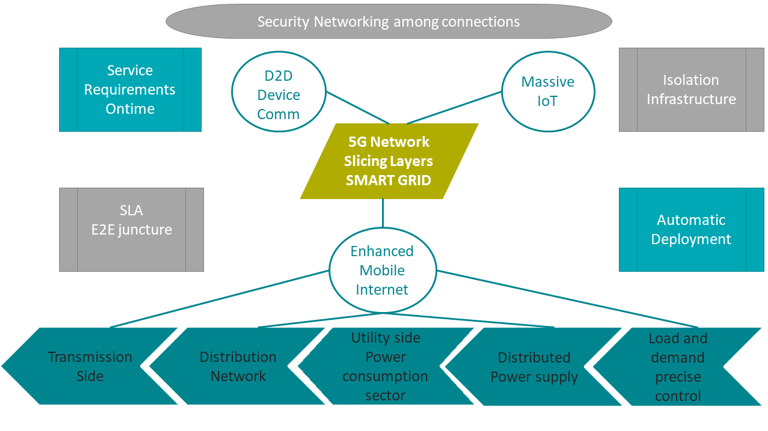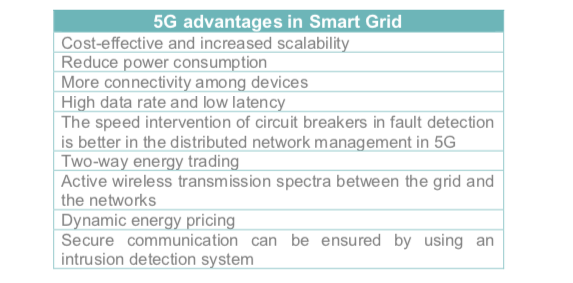Analysis of wireless technologies, roadmap architecture of 5G and smart grids
Wireless communication is important as a reliable, efficient, and intelligent way to enhance the conventional power grids into smart grids. Wireless technologies ensure low installation costs and flexible deployments providing connectivity over extended areas or in environments without existing communication infrastructure.
For the current overview, we will consider two cases:
- Use of a commercial public network where the operators can offer a dedicated service level agreement (SLA).
- Deployment of a Smart Grid in a private network by utilities or by third parties avoiding problems of radio resources.
Wi-Fi (IEEE 802.11)
Wireless Fidelity (Wi-Fi) is a popular wireless local area network technology used for home applications. It operates in the unlicensed 2.4 GHz and 5 GHz bands and thus it is subject to interference with other technologies sharing the same spectrum.
900 MHz band and GSM/GPRS
Global System for Mobile/General Packet Radio Service (GSM/GPRS) is currently very often used by mobile operators even if there are other more advanced mobile technologies available. Smart Grid operating in 900 MHz frequency applies GSM/GPRS. However, although this technology seems a feasible solution in terms of investments for its wide availability and good coverage in indoor conditions, results from trials performed by Ernst & Young have shown that its features are insufficient for smart meters.

450 MHz band, CDMA and future LTE
The lower frequency of 450 MHz presents a relevant advantage against GSM 900 MHz and Long Term Evolution (LTE) 800 MHz, due to its availability in many countries and lower usage. Code Division Multiple Access (CDMA) presents better propagation characteristics and requires four times fewer base stations.

800 MHz band and LTE
Long Term Evolution (LTE), is the fourth generation (4G) of cellular communications, which allows getting over some of the GSM shortcomings, like insufficient coverage in indoor conditions for smart meters. This technology provides high capacity, low latency, secure and reliable data-packet switching. Compared with its predecessors, LTE uses new access schemes on the air interface for downlink and uplink, which brings flexibility in scheduling as well as power efficiency.
The fast roll-out of LTE has led to the wide use of this networking technology for, among others, smart metering, distribution automation, fault location, etc. Consequently, LTE is a promising choice to support IEC 61850 together with the Manufacturing Message Specification (MMS) protocol, for smart metering and remote-control services. The simulation carried out in Performance of LTE for smart grid communications assess the LTE capability to support IEC 61850 abstract objects and services mapping, by studying if LTE fulfils requirements like scalability, latency, reliability or QoS. This analysis highlights the functionality of Medium Access Control (MAC) scheduling mechanisms, which can be used to implement prioritisation of IEC61850 messages over background traffic. Throughput and packet loss ratio are measured at the Packet Data Convergence Protocol (PDCP) layer, while the delay is measured at the application layer. This study, along with others, present LTE as a good candidate to form part of the communication layer of the ebalance-plus platform.

The previous technologies, GSM and LTE count with the drawbacks of not being able to guarantee dedicated resources and private network conditions to ensure reliability and prioritisation for Smart Grid services. These shortcomings are addressed by the fifth generation (5G) or 5G New Radio (5G NR) and by the Network Slicing.
Fifth Generation, 5G
This new technology presents the ability to promote full networking among countries overcoming the expectations of previous cellular technologies. To provide high-quality 5G services, several technologies have emerged:
- Millimeter wave communication offers low latency by using mm-wave spectra ranging [3-300] GHz. Besides, this technology provides very large bandwidth allocation, which supports higher throughput than the existing 4G systems.
- Hetnets, the 5G wireless networks require a high demand for data rates. Hetnets solve this requirement by allowing densification of the network by deploying small cells that are placed in indoors and outdoors. As result, it provides higher spectral efficiency and can reduce the consumption of a mobile device due to its communication with nearby pico-cell. This solution improves network coverage and capacity.
- Massive Multiple-input Multiple-output (MIMO), which consists of the use of extensive service antennas with spatial multiplexing. This technology allows concentrating radio energy into smaller areas, obtaining higher throughput and efficiency.
- Visual Light Communication, also called Light Fidelity (Li-Fi) or optical wireless communication, presents advantages like low power, less interference, and very high spatial reuse which becomes a proper choice for indoor communication in 5G.
5G networks usually use significant core technologies such as IoT and Software Defined Networks (SDN). SDN decouples the control and data planes to get superior programmability, adaptability, and flexibility in network architectures. The combination of these SDN solutions with the IoT is considered the bridge to 5G networking.
The data traffic distribution in a Smart Grid network can be classified into two sections:
- the first segment – HAN, which involves interaction between the utility and the users through connections like smart meters and sensors, and
- the second segment comprising the direct connection between the utility providers and the generation side.
The architecture of 5G and Smart Grids tackles both the transmission and the distribution sides. The 5G network slicing layers of its architecture comprise multiple domains at both the user and utility sides. Some of the features of 5G slicing are the on-demand deployment, where the network functions are analysed based on the service needs. Also, 5G network slicing can be perceived as one network sliced into multiple instances, where each one can be optimised for specific requirements/application/services. Slicing allows the deployment of several virtual networks on a single physical infrastructure, allowing resource isolation and customised operations.


Smart Grid 5G slice deployment involves virtualised network functionalities and infrastructure layers by the use of Network Function Virtualisation (NFV), which reduces machine interconnection and configuration time, while improving productivity. NFV services can simplify machine data collection, aggregation and analysis.
The concurrent connection between wireless transfers with simultaneous power entities promotes wireless communication. Nevertheless, high initial investment and low availability during bad weather conditions or natural disasters make it a less preferred approach.

To summ up, there are many advantages of using 5G networks in Smart Grids:
